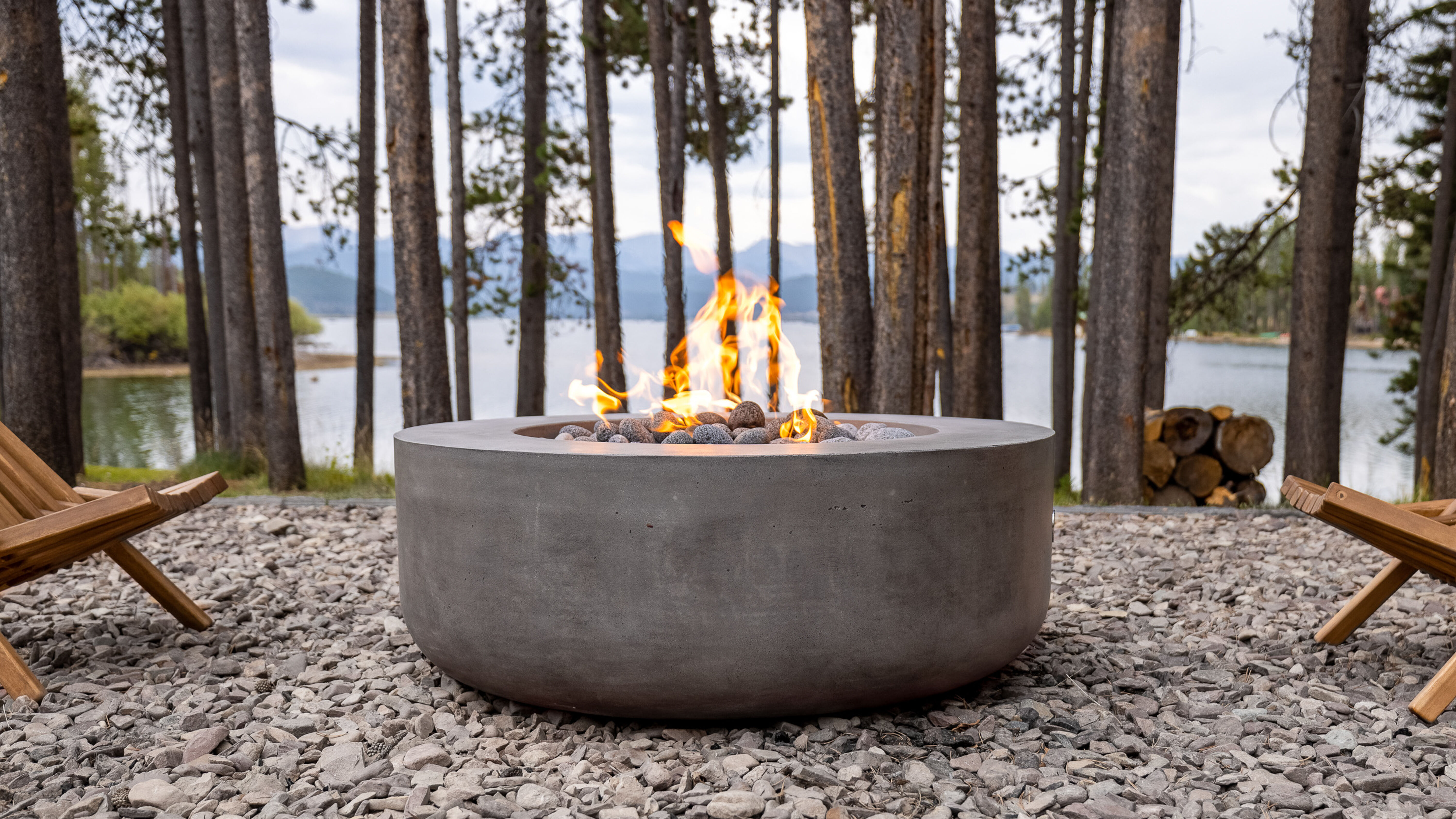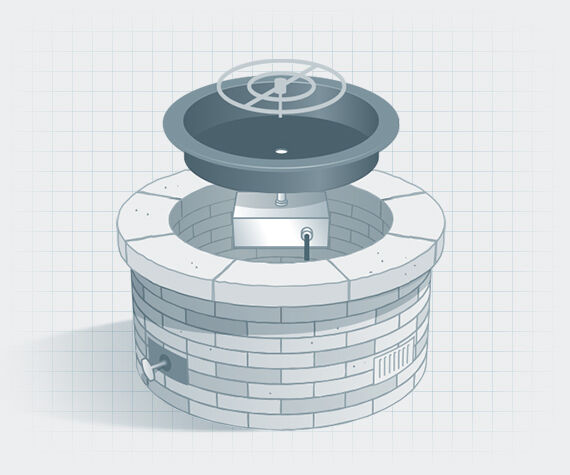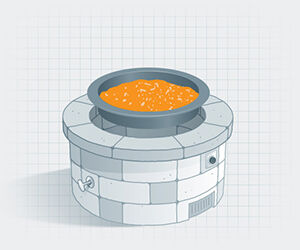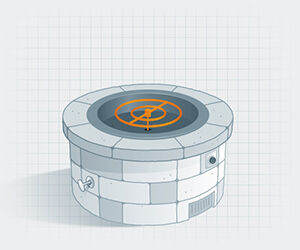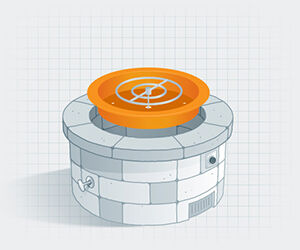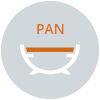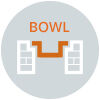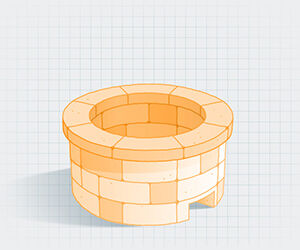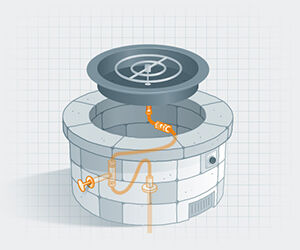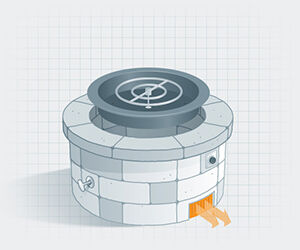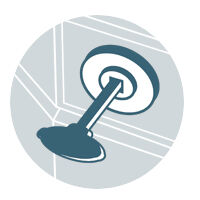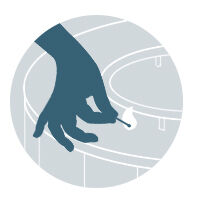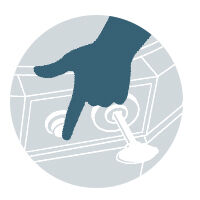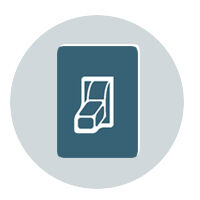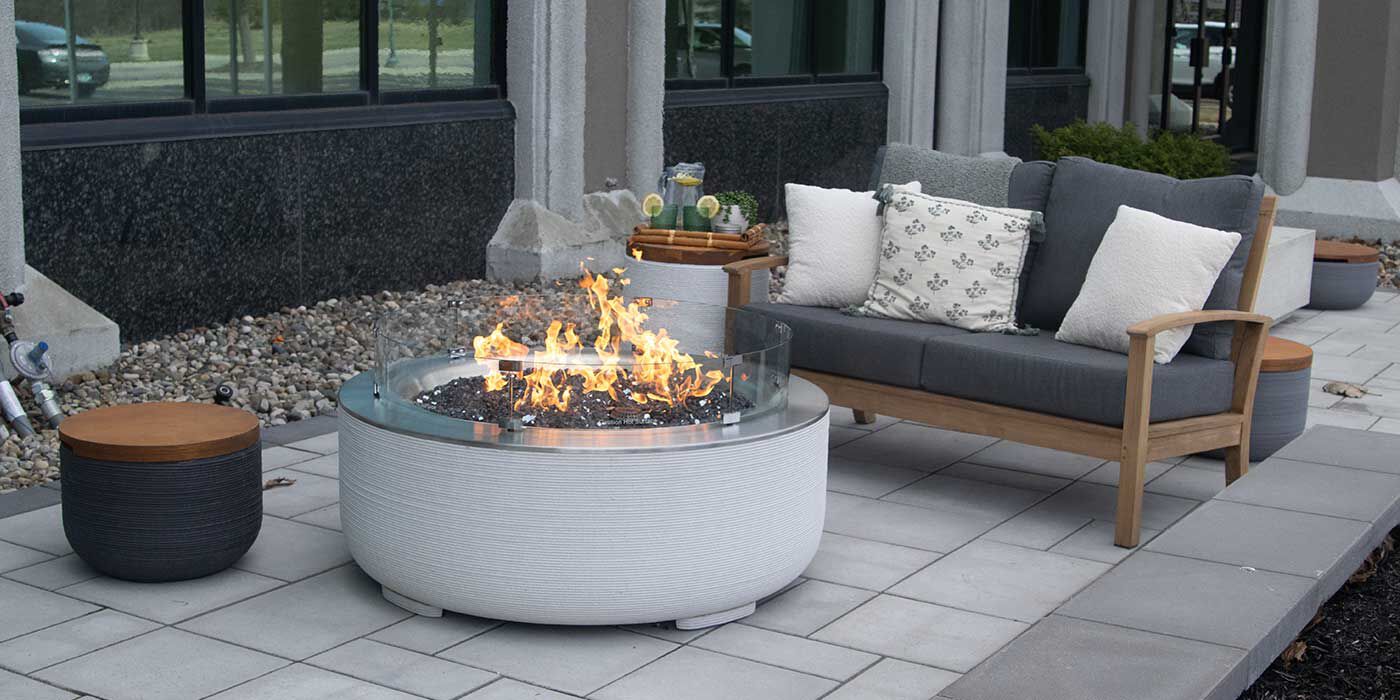By: Thomas Kearney, NFI Certified Master Hearth Professional
Last Updated: July 24, 2025
While some gas fire pits may appear more complicated than others, they all have the same basic components, including:
- Enclosure
- Burner and pan
- Burning media
- Ignition system
- Gas/fire controls
In this article, we'll explain why each of these gas fire pit parts are important, how they work, and what kind of upgrades are available.
Gas Fire Pit Components
Media
Media is essential for both Natural Gas and Propane fire pits. It helps distribute the gas and create a more natural flame pattern.
Fire pit media is placed on top of the burner and takes the place of traditional wood logs.
There’s a variety of media styles available to match the vibe of your outdoor living space, including:
Fire glass: Create a contemporary and eye-catching burning display with small, medium, or large fire glass pieces in the color of your choice.
Lava rock: Achieve a classic, timeless burning display that’s easy to take care of.
Rolled lava stones: Upgrade from traditional lava rock to modern rolled lava stones for a more modern touch.
Outdoor log sets: Replicate the look of a real wood burning fire pit, without the hassle of chopping wood, stoking the fire, or adding logs all evening.
Fireballs & decorative metal shapes: Turn your fire pit into a work of art that sparks conversation.
To take a closer look at all the media options we have on our site, check out our Fire Pit Media Buying Guide.
Burner
The burner sits under your fire pit media and burns your fuel (Liquid Propane or Natural Gas).
Available in an array of shapes and materials, gas fire pit burners dictate how your flame display looks and how much heat your fire pit puts out.
You’ll want to research different types of burners and the amount of gas they can burn at once (BTU rating).
Pan
The pan sits directly under the burner and media, separating them from the open cavity below.
Pans come in many shapes and sizes, and either sit on the top of the fire pit or are recessed into the fire pit.
Common Pan Shapes
Fire Pit Enclosure
The enclosure is the body of the fire pit. Enclosures come in various shapes (round, square, rectangular, etc.) and heights (chat height, bar height, dining height, etc.).
Connectors and Fittings
Connectors and fittings are small parts inside the base of your fire pit that are used to route gas from your Propane tank or gas line to the burner.
These pieces can include things like a gas connection hose with fittings, a gas regulator, valve, and orifice. The connector hose is a small flexible pipe that attaches the gas valve to the burner.
Vents
Control Types
Key Valve
Control Knob
Remotes and Switches
Remotes and switches are available with automatic ignition fire pits. Just like a TV remote, a fire pit remote allows you to turn the fire on and off without having to get up to do it manually. Most remotes are on/off only, but some do allow you to change the flame height.
You can also have a gas fire pit wired to a simple wall switch in your outdoor room, enabling you to turn the fire pit on and off with ease.
Ignition Types
Match-Lit
Push-Button
Pro Tip:
Some push-button ignitions use a safety pilot system. A safety pilot system will reignite the fire or shut the gas off completely if the flame ever goes out. Safety pilot ignitions are safety rated, making them the most affordable way to be very safe when lighting a gas fire pit.
Automatic Ignition
An electronic ignition (automatic ignition) operates by pressing a button or flipping a switch to turn the fire pit on and off. It uses a valve system that typically requires an electrical connection and can be controlled with a remote or wall switch.
It’s the safest and most user-friendly option available, but also the most expensive.
Read our comprehensive guide to ignition systems here, so you can confidently choose the best option for your project.
Optional Accessories for Your Fire Pit
Glass Wind Guard
A glass wind guard sits around the media and burner, protecting the flame and allowing the fire pit to stay lit on blustery days.
Wind guards are not required but are a very practical addition if you live in a windy area.
Protective Covers
Protective covers are used to keep fire pits safe when they’re not in use. They protect against unnecessary damage from tough weather conditions and help to prevent rust and deterioration from occurring.
Materials range from weather-proof vinyl to stainless steel and can cover just the burner component or the entire fire pit.
Gas Fire Pit FAQs
Can I convert my Propane fire pit to Natural Gas?
It depends on the fire pit you purchase. Some fire pits offer conversion kits, allowing you to change your gas supply.
For homeowners who don’t already have a gas line, it’s best to hire a licensed and certified professional to hook up fire pit. Having a pro handle your gas appliances ensures there are no dangerous gas leaks.
What’s the best location to install my gas fire pit?
Ideally, your fire pit should be installed on a flat, level surface, like a stone patio, deck, or flat yard. For installations on decks, you’ll need a non-combustible base underneath your fire pit to prevent radiant heat from transferring to the surface below. For grass installations, you don’t need a non-combustible base, but you will need to ensure your fire pit is installed on a surface that can support its weight without shifting.
What kind of burner should I get?
It depends on what shape your fire pit, what you want your flames to look like, and how much heat you need. Make sure the burner system you purchase is compatible with type of fuel you want to use.
Burners from HPC Fire are perfect for every outdoor setting. Available in a variety of sizes and shapes, they’re made of high-quality, weather-resistant materials, like stainless steel, and come with a variety of easy-to-use controls. Some HPC burners even allow you to pair a smart phone to your fire pit and control it with an app.
What are the benefits of a gas fire pit over wood burning models?
Gas fire pits are convenient, easy to ignite, produce less smoke, and require less maintenance. They are also more environmentally friendly due to lower emissions.
We're Here to Help
Have any questions about gas fire pits? We'd love to help! Call our NFI certified experts at (800) 919-1904 today.
More Resources
Not sure what fuel source to use? Learn the key differences between Natural Gas and Propane fire pits to make the right decision.
Check out our top burner kits for custom-made and DIY gas fire pits.
If want a permanent, Natural Gas fire pit but don’t have a gas line on your property, you’ll need an NFI Certified pro to do the job.
 |
Tom Kearney has been a Technical Sales Representative at Woodland Direct for over a decade, where he has honed his expertise in gas, wood, and pellet appliances as an NFI-Certified expert. Tom's dedication to customer satisfaction is exemplified by his work with high-profile clients, including assisting SpaceX President Gwynne Shotwell in sourcing five stunning fireplaces for her Texas home. When he's not helping clients find their perfect fireplace, Tom enjoys hitting the golf course, skiing down snowy slopes, and exploring new trails on his bike. Call him or one of our experts in fire at 800.919.1904. |
